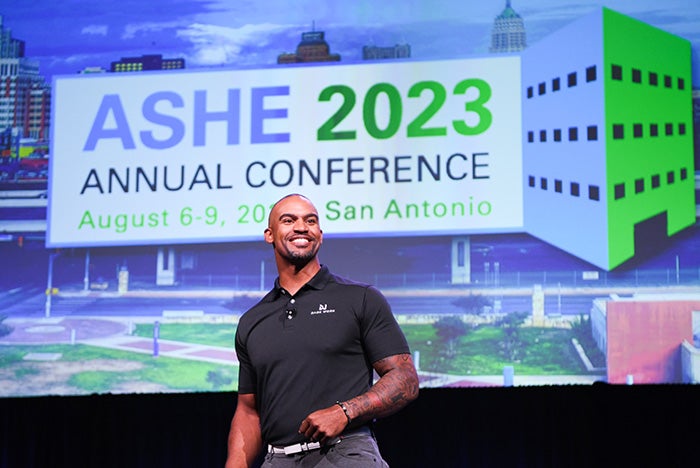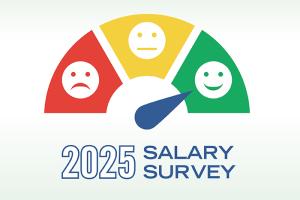ASHE embraces change at 60th Annual Conference

Keynote speaker Anthony Trucks talks about how to "Make Shift Happen" at the 2023 ASHE Annual Conference & Technical Exhibition.
Image courtesy of ASHE
The American Society for Health Care Engineering (ASHE) celebrated its 60th anniversary at the ASHE Annual Conference & Technical Exhibition last week in San Antonio, and shared plans to evolve its flagship event as the Health Care Facilities Innovation Conference for the next 60 years and beyond.
The refreshed conference will hold its inaugural gathering July 21-24, 2024, in Anaheim, Calif., and future attendees can sign up for updates on registration and more.
But before introducing the new conference brand, ASHE kicked off its 2023 event with a message on how to shift.
Anthony Trucks was this year's keynote speaker and shared strategies on how to “Make Shift Happen.” Trucks, who is a former NFL football player, American Ninja Warrior contestant, author and host of the podcast “Aww Shift,” challenged attendees to create clear objectives and intentions for their goals, relaying that it’s hard to know where one is going without first setting a destination.
“In order to reach the next level of success, you have to do something different,” Trucks says. “You have to shift with shifting times.”
The speaker gave five tips to help leaders develop a “shift” mindset:
- Start right with a morning routine.
- Make healthy choices to build confidence.
- Complete an important task, especially one that's been avoided.
- Find joy, gratitude and silver linings.
- Track progress for motivation.
Monday’s keynote address set the stage for the week’s remaining general and concurrent sessions, which, although more technical in nature, still centered on setting goals to optimize the physical environment by shifting into new ideas, technology and processes to achieve those goals.
In the session “Every Byte Counts: Why RCM Needs Cybersecurity,” speaker Rick Joslin, senior advisor of health care strategy at Accruent, discussed the convergence of information technology and operational technology (OT) as health care continues integrating the Internet of Things into building infrastructure.
Although patient data is still the most vulnerable to cyberattacks, Joslin advises facilities managers to proactively protect OT systems, as well, especially since he foresees the Centers for Medicare & Medicaid Services introducing regulatory oversight for health care cybersecurity in the next three to five years. His advice: identify blind spots, adopt network segmentation and install cyber protection with alerting capabilities.
Overcoming challenges
The morning general session on Day 2 addressed the hard-to-navigate issue of health care workforce shortages, which is not limited to clinical staff. ASHE Deputy Executive Director Chad Beebe, AIA, CHFM, CFPS, CBO, FASHE, was joined by Jim Prister, FACHE, president and CEO of RML Specialty Hospitals, to discuss how pandemic-induced workforce shortages and staff burnout have strained care delivery.
Prister, who is on the American Hospital Association’s (AHA’s) Board of Trustees, shared a framework developed by the AHA Workforce Task Force that approaches the issue from three perspectives: now, near and far. As people retire at a faster clip and health care undergoes more consolidation, Prister says the challenge will only grow. While focusing on the now, “We also have to think 10 years from where we are today,” he says.
To overcome these challenges, leaders need to develop interpersonal skills to help staff navigate mental health burnout, Prister says. Also, partnering with STEM programs can help to create pathways to apprenticeship leading to rewarding careers. Leaders can find more ideas in the 2023 AHA Health Care Workforce Scan.
The day's concurrent sessions addressed topics ranging from how to participate in code development to planning for a clean energy transition. The latter topic focused on Memorial Sloan Kettering Cancer Center’s goal to reduce greenhouse gases and how it navigated funding challenges to install a new electric hot water system.
Sharing the wins
Day 3 of the conference kicked off with a breakfast to honor several ASHE award winners. ASHE Executive Director Elizabeth “Lizzie” Ortolano and ASHE President Gordon Howie, MSPM, CHFM, CHC, led the award ceremony.
Afterward, Jonathan Flannery, senior associate director of advocacy for ASHE, was joined by Jeff O’Neill and Jordan Northcutt Plyler on updates from the ASHE Advocacy Team and the Member Tools Task Force (MTTF). The MTTF is comprised of knowledgeable ASHE members who develop articles, tools and resources addressing some of the field’s toughest compliance challenges.
Aptly, the advocacy update was followed by a number of sessions from accrediting organizations, including The Joint Commission, the Accreditation Commission for Health Care, DNV-GL Health Care USA, Inc. and The Center for Improvement in Healthcare Quality, all detailing how hospitals can stay survey-ready.
The conference then closed with a general session on sustainability, which is a topic front and center for many health care facilities.
Lindsey Brackett, CHC, CHFM, SASHE, chief empowerment officer at Legacy FM, led a panel discussion featuring experts in health care sustainability, including Kara Brooks, MS, LEED AP BD+C, senior associate director of sustainability at ASHE; Richie Stever, CHFM, CLSS-HC, LEED AP, vice president of real estate and construction at the University of Maryland Medical Center; Terri Scannell, principal advisor of sustainability, and environmental, social governance at OhioHealth; and Walter Jones Jr., AIA, LEED, EDAC, senior vice present at The MetroHealth System.
Each shared sustainability wins at their facilities and how they were able to achieve them. A common theme at the roundtable discussion was learning how to tell your story to gain support among the C-suite and other staff. For instance, Stever describes an initiative to engage more staff in decarbonization efforts by featuring sustainability wins in the health system’s newsletter.
Stever encouraged attendees to figure out ways to do the same. “Tell your story. Expand your audience outside of the facilities department,” he says.




